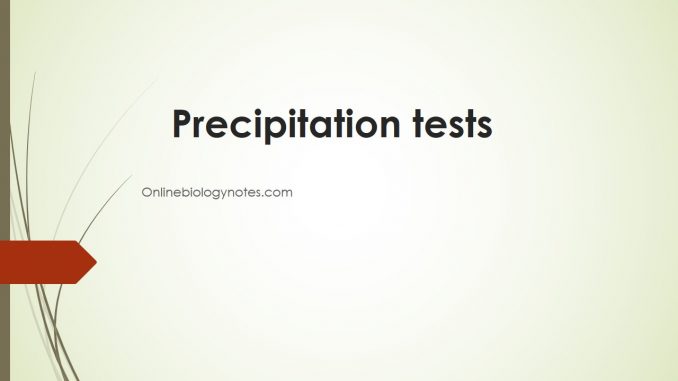
Precipitation test
- When bivalent antibody combines with multivalent soluble antigen, visible precipitation is formed which is indicator of antigen-antibody reaction.
- If precipitate remains suspending instead of sedimentation, it is called flocculation test.
- In order to occur precipitation Ag-Ab must be in appropriate concentration.
- When antibody concentration is too high and antigen concentration is too low, visible precipitate is not found. This inhibition of precipitation by excess antibody is called prozone effect.
- On the other hand when antibody concentration is too low and antigen concentration is too high, visible precipitate is not formed.
- This inhibition of precipitates by excess antigen is called post-zone effect.
- Precipitation occurs only when antigen and antibody are in appropriate concentration (4:1)
- Region is the graph where precipitate occurs maximally is called equivalence zone.
- Formation of precipitate can be described by lattice hypothesis.
- When antigen and antibody are in appropriate concentration, maximum cross linking of antigen by antibody occurs so that visible precipitate is formed.
- Either excess antigen or excess antibody prevents extensive cross linking of antigen by antibody so that visible precipitate is not formed.
- This is the reasons why the precipitate occur only in equivalence zone but not in prozone and post zone.
Types of precipitation tests:
1. Simple precipitation test
i. Slide precipitation/flocculation test
- This test is carried out on glass slide.
- One drop of reagent (either antigen or antibody) is placed on a slide. Then one drop of serum sample is added to it.
- Then the slide is rotated to mix the serum and reagent.
- If precipitate is formed it indicates a positive test.
ii. Tube precipitation test
- A clear solution of sample containing antigen is layered slowly as to a clear antibody solution in a narrow test tube
- After certain period a white ring of precipitate appears at the junction of two liquids.
2. Immuno-diffusion test (gel diffusion)
i. Oudin method
- In this method precipitate is carried out in gel.
- It is single diffusion test in one direction.
- Antibody is incorporated into gel in a test tube.
- Sample containing antigen is placed into the test tube.
- Antigen diffuses into the gel and form line of precipitate where antigen and antibody met in appropriate concentration.
ii. Okley-fulthorpe variation of Oudin
- It is double diffusion test in one direction.
- Antibody is incorporated into gel in a test tube.
- Above this gel, a plane gel is solidified.
- Sample containing antigen is placed above the plane gel.
- Both the antigen and antibody diffuse into the plane gel and form visible precipitate where they met in appropriate concentration.
iii. Radial immune-odiffusion
- It is single diffusion test in two dimension.
- It is quantitative test and is used to determine concentration of antigen or antibody in sample.
- Wells are made on agar gel by using template and sample containing antigen is placed into the well.
- Specific antibody is incorporated into gel and form visible ring of precipitate around the well where antibody and antigen met in appropriate concentration.
- Diameter of ring of precipitate is directly proportional to concentration of antigen in sample.
iv. Ouchterlony method
- It is double diffusion test in two dimension.
- Wells are cut an agar gel using a template.
- Serum containing antibody is placed into central well and different antigens are placed into surrounding well.
- Both antigen and antibody diffuse from the well and form visible precipitate.
- This technique is used to identify relationship between two antigens.
- Three different pattern of precipitation occur in different cases
- If two antigen are similar, line of precipitate fused
- If two antigen are non-identical, line of precipitate crossed
- If two antigen are partially identical, spur formation of precipitate occurs.
v. Immuno-electrophoresis
- This technique is used to detect and isolate particular protein in serum of patient.
- For example, to detect cancerous mixture of proteins. At first serum containing mixture of protein is placed in well on gel. Then proteins present in serum are separated by electrophoresis.
- After electrophoresis protein present in serum form distinct band. Then a parallel trough is cut in gel and solution of specific antibody is placed in it.
- A precipitate band is formed where antigen and antibody met in appropriate concentration.
vi. Rocket electrophoresis
- It is a quantitative test and is used to measure concentration of antigen or antibody in sample.
- Antibody is incorporated in gel and sample containing antigen is placed in well. Then electrophoresis is carried out.
- Antigen and antibody combine to from rocket shaped precipitate band where length is directly proportional to concentration of antigen.
vii. Counter current immune-electrophoresis
- Agar gel is taken and two wells are made at opposite end of gel.
- Sample containing antigen is placed in one well and specific antibody is placed in another well.
- During electrophoresis negatively charged antigen migrate toward anode and positively charged antibody migrate towards cathode.
- Antigen and antibody combine to form line of precipitate where they met in appropriate concentration.
- This technique is rapid and more sensitive than simple immune-diffusion method.
- pH of gel should be 8.6 at which antibodies have positively charged and antigen have negative charge
Application of precipitation tests:
- to identify microbes (bacterial cells)
- to detect antigen in serum or other sample
- to detect antibody in serum or other sample
- to detect toxin or anti-toxin
- to detect food adulteration
- It can be used to measure concentration of antigen or antibody. Eg by radial immuno-diffusion
